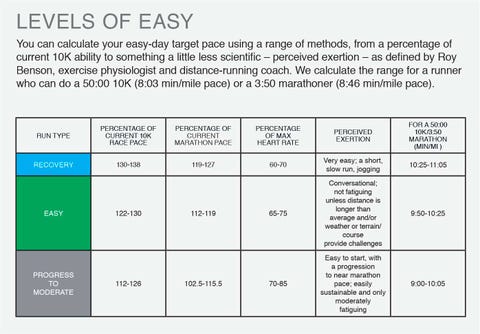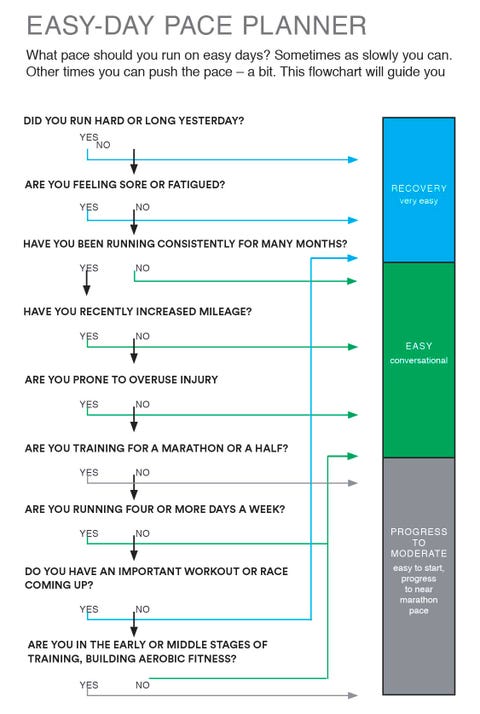Are Miles Underneath 6 Mins Easy for the Average Person
Easy miles form the backbone of most training schedules. But are you running those miles too fast – or too slow?
What are easy miles?
They're all the other miles – not the tempos or track repeats or long runs. They're the entries in your training log that make up a large percentage of your weekly mileage total, but for which you don't bother to record much data: simply an '8' or a '6' or a 'park loop' suffice to remind you what you did that day. Some hardliners might even use the term 'junk miles' for easy-day running. So why do we do them? Because easy running – even very slow easy running – provides fundamental adaptations.
On easy days, you're using mostly slow-twitch muscle fibres. They have a higher density of mitochondria, high levels of aerobic enzymes and greater capillary density than fast-twitch fibres, which are more involved in higher intensity training, says Dan Bergland, principal sport physiologist at Volt Sportlab in Flagstaff, Arizona, US. On easy days, 'You increase mitochondria and capillaries and blood flow to those muscles, so they're better able to utilise oxygen,' he says. 'Without that, you can't do the intense runs.'
All runners, and especially beginners and those coming back from injury, benefit from the cardio-vascular and muscular-structural development easy running promotes. The base fitness a runner puts down through a preponderance of easy runs enables the athlete to safely progress to other types of training.
Seasoned runners also need easy days to maintain hard-earned aerobic fitness and make continual gains in economy. Of course, competitive runners are interested in moving efficiently at race paces – the primary reason for training at a variety of intensities – in addition to running easy. But even slow running allows for gains in efficiency of movement.
More importantly, it allows for recovery from hard days. 'A runner should achieve a training effect every day,' says running coach Dennis Barker, 'and to me, recovery is a training effect, maybe the most important one. It's during recovery that adaptations from hard training take place. If a runner doesn't recover, the body is not going to adapt, and you'll either continue digging a hole for yourself or get injured.'
What pace should you be doing your easy runs at?
The questions, then, are what pace is right, and what do you stand to lose if you go too fast or too slow? In a general sense, an easy run is a low-intensity effort of a short to moderate duration. So a long run, even at a relaxed pace, should not be considered 'easy', because, despite the pace, there comes a point where the duration raises the overall intensity out of the comfort zone.
Though Barker extols the virtues of keeping the pace relaxed on easy days, that doesn't mean he sends his athletes out for short jogs. In fact, he's been known to assign runners hilly routes on non-workout days, to give the run a little extra benefit. But pacing is almost always reined in.
'Pace is the most important thing to keep easy on an easy day,' says Barker. 'Many runners can still recover if they run a few more miles, as long as it's still at an easy pace. But from my experience, they can't recover if they run a faster pace, even with fewer miles. So pace really needs to be governed on easy days, [but] mileage not quite as much.'
Bergland believes runners can't really go too slow on their easy days, unless their form starts to suffer. At that point, slower becomes counter-productive. In his opinion, as long as your form holds up, lower intensity trumps higher intensity for easy days.
While elite athletes have a finely tuned sense of pace and effort, recreational runners often struggle with it. Bergland advises runners to use 10K race pace plus two minutes for easy-day pace, wear a heart-rate monitor (aim for 65-70 per cent of max heart rate) or occasionally use treadmill runs to monitor your pace.
What happens if you run too fast on easy days?
Running coach Ian Dobson, who works with athletes of all ages and abilities, has found many runners fail to back off on easy days. He meets weekly with Team Run Eugene Flyers, a group of recreational runners, to oversee workouts. 'I see some of them warm up and then run mile pace and 5K pace and marathon pace, and it's indistinguishable; they're just running, you know?' he says. 'Those people are suffering from this stuck-in-one-pace kind of thing. And it's because they don't want to run 11-min/mile pace, or whatever they really need to be running, on their recovery runs.'
Those who don't run their workouts hard enough are stuck in a middle ground, in third gear. 'The common denominator among most really successful runners, people running at a high level, is a really wide chasm between training-run pace and where they work out,' says Dobson. 'It's kind of counterintuitive, but when total volume is high, your average training-run pace is probably also a bit higher.' He explains that you see this with marathoners – when an elite athlete is running more than 100 miles a week, chances are his or her average training-run pace is faster than an 800m runner or miler running only 30 miles a week. The miler is running really fast when they're on the track and really slow when they're not. US middle-distance runner Brenda Martinez, who has PBs of 1:57.91 for 800m and 4:00.94 for 1500m, is a perfect example of this. Under the guidance of coach Joe Vigil, she'll run 8 x 1,000m repeats at 2:55, but on her easy days, she'll run 9 min/mile pace.
How to run at a much slower pace
Some runners find it hard to maintain the slower paces. Jason Ryf, who ran the 2013 Boston Marathon in 2:23:06 at the age of 42, rarely trains slower than six minutes per mile. Most training calculators would suggest that Ryf run his easy mileage in the 6:15-6:40 range, but he just can't do it. 'Believe me,' he says, 'I go through the struggle quite a bit – "Hey, I should be going slower' – because all the training books would have me going easier. I do plan on it sometimes, but after a couple of miles I'm back at six-minute pace.'
But Ryf's training is solely focused on the marathon. Any racing he does at shorter distances is part of training for his next 26.2-miler, and his PBs at 10K, 10 miles and the half marathon pale in comparison to his marathon performances. If he targeted shorter distances, Ryf would modify his approach. 'I would probably try to back off a little bit, so my legs would be fresher for workouts,' he says.
Track and field coach Ray Treacy has his athletes running towards the faster end of the scale on most non-workout days and expresses disdain for 'jogging'. He schedules workouts every fourth day, less often than is typical, and tells his athletes to go truly easy only immediately following hard training sessions. 'The day after the hard workout might be easy,' says Treacy, 'but the other two days you're trying to get something out of it, to improve your fitness. Let's put it this way: I wouldn't like to waste a day's training on a jog.'
Some physiologists agree with the faster approach. One of those is Bob Otto, professor of health and sport sciences at Adelphi University, US. The question, he asks, is what does a slow run accomplish? He details the downsides of going slow: it provides orthopaedic trauma, allows athletes to practise something they'd never use in a race and provides insufficient cardiovascular or metabolic stimulus to accrue improvement.
'Conversely, the faster-paced run may provide cardiovascular stimulus, may enhance metabolic function, mimics the biomechanics of race pace and, hopefully, provides less orthopaedic trauma than the slow run,' he says. 'Although the ideal scenario is to decrease one's stride frequency to run slower and maintain a similar biomechanical foot strike, we know most people change their mechanics significantly and their stride frequency moderately. I am an advocate of practising like you want to perform and find little value in a "slow run".'
For some athletes, moving too slowly throws them off. 'I like to get athletes into a rhythm, whether it's a recovery day or a general day, and not worry about pace so much. Make sure you're getting something out of it but not killing yourself,' says running coach Brad Herbster.
What's right for you?
Returning, then, to the easy six-miler you do a few days a week: would you benefit from speeding up or slowing down? The answer, of course, depends on your goals, your other workouts, whether you're hitting a variety of speeds during the week, your total weekly mileage, what your body is telling you each morning – and what time you have to be at work.
'Runners have to pay attention and learn about themselves, because an easy day will be different based on how long you've been running, what you're training for, how much mileage you have in your legs, all sorts of things,' says Barker.
While you never need to emulate the programme of another runner, you might experiment with varying the pace of easy miles – and test the changes with a race. Maybe you'll find it's not the hard efforts – the number of reps or the grade of the hill – that will make the difference in your training. Maybe it's what you're doing on the easy days.
Source: https://www.runnersworld.com/uk/training/beginners/a26514237/running-pacing-easy-miles/


0 Response to "Are Miles Underneath 6 Mins Easy for the Average Person"
Post a Comment